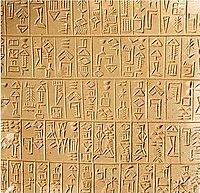
Back Ашумер бызшәа Abkhazian Sumeries Afrikaans لغة سومرية Arabic لغه سومريه ARZ Idioma sumeriu AST Шумер мацӀ AV Şumer dili Azerbaijani سومر دیلی AZB Шумерская мова Byelorussian Шумерски език Bulgarian
| Sumerian | |
|---|---|
| 𒅴𒂠 eme-gir15[1] | |
 | |
| Native to | Sumer and Akkad |
| Region | Mesopotamia (modern-day Iraq) |
| Era | Attested from c. 2900 BC. Went out of vernacular use around 1700 BC; used as a classical language until about 100 AD.[2] |
| Dialects | |
| Sumero-Akkadian cuneiform | |
| Language codes | |
| ISO 639-2 | sux |
| ISO 639-3 | sux |
uga | |
| Glottolog | sume1241 |
Sumerian (Sumerian: 𒅴𒂠, romanized: eme-gir15[a], lit. ''native language''[1]) was the language of ancient Sumer. It is one of the oldest attested languages, dating back to at least 2900 BC. It is a local language isolate that was spoken in ancient Mesopotamia, in the area that is modern-day Iraq.
Akkadian, a Semitic language, gradually replaced Sumerian as the primary spoken language in the area c. 2000 BC (the exact date is debated),[5] but Sumerian continued to be used as a sacred, ceremonial, literary, and scientific language in Akkadian-speaking Mesopotamian states such as Assyria and Babylonia until the 1st century AD.[6][7] Thereafter, it seems to have fallen into obscurity until the 19th century, when Assyriologists began deciphering the cuneiform inscriptions and excavated tablets that had been left by its speakers.
In spite of its extinction, Sumerian exerted a significant impact on the languages of the area. The cuneiform script, originally used for Sumerian, was widely adopted by numerous regional languages such as Akkadian, Elamite, Eblaite, Hittite, Hurrian, Luwian and Urartian; it similarly inspired the Old Persian alphabet which was used to write the eponymous language. The impact was perhaps the greatest on Akkadian, whose grammar and vocabulary were significantly influenced by Sumerian.[8]
- ^ a b Jagersma (2010: 1), Zólyomi (2017: 15), Foxvog (2016: 21), Edzard (2003: 1), ePSD2 entry for emegir.
- ^ "Sumerian". Archived from the original on 27 June 2013. Retrieved 2024-04-07.
- ^ a b Jagersma (2010: 6-8), Zólyomi (2017: 19), Zamudio (2017: 264)
- ^ ePSD2 entry for emegir.
- ^ Cite error: The named reference
woodswas invoked but never defined (see the help page). - ^ Cite error: The named reference
oates79was invoked but never defined (see the help page). - ^ Cite error: The named reference
grayson80was invoked but never defined (see the help page). - ^ Hasselbach-Andee, Rebecca (2020). A Companion to Ancient Near Eastern Languages. Wiley-Blackwell. p. 132. ISBN 978-1-119-19380-7.
Cite error: There are <ref group=lower-alpha> tags or {{efn}} templates on this page, but the references will not show without a {{reflist|group=lower-alpha}} template or {{notelist}} template (see the help page).